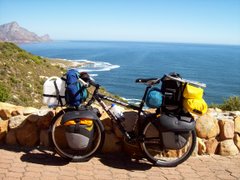



After a short trip across the Gulf, the high speed ferry delivered us in Jordan. We managed to find our way in the dark to the city of Aqaba, where we acclimatised for a day before climbing North into the mountains along the "Kings Highway". A day was spent exploring the magnificent ancient city of Petra, with it's amazing structures carved into the mountainside. The late winter weather saw to it that we were hiding in our room in the nearby town of Wadi Moosa for another day before proceeding along the mountain ridges towards the Dead Sea. On the road it was quite chilly, with patches of snow from the previous day (I couldn't resist lobbing a snowball or two at Leana - she wasn't impressed!). After that we dropped steeply down to the warm weather of the Dead Sea, where the GPS told us we were 394 m below sea level (after being about 2000 m high the previous day). We did the obligatory floating thing, where the salty water would have cured us of any ailments (if we had any). From there we spent a whole day climbing uphill to the capital, Amman. Along the road we met Peter & Jill (ex NZ & SA), who had been out for a day's cycling in the mountains. They've been living and working in Amman for the past 4 years, and they invited us to their home for an enjoyable braai one evening. Things in Jordan are very expensive, but we have managed to stock up on a number of essential (and non-essential) items. Leana needs to replace a damaged wheel rim on her bike, and as we can't find a suitable rim here we've ordered it (and other spares which we'll need in future) from Cycle Maintenance Centre in Cape Town. The shipping costs about half the price of a new bike, so we've asked Leana's sister, Amanda, to fill up the parcel with some SA luxuries like pasta sauce and dried sausage. While we wait for the spares to arrive we're exploring the place. Amman is a relatively westernised city of about 2 million, and all the buildings (even the new ones) have a chalky stone appearance. Buildings, especially in the older areas, are perched precariously on the many hillsides over which the city is built. One of the sites we've seen is the old Roman Theatre (photo), just around the corner from our room in the old downtown area. We would have liked to make a turn in Lebanon, but after a visit to their embassy it seems unlikely. Once we've finished our business here, we plan to move North towards Syria, where we hope to obtain a visa at the border. Distances cycled since Dahab were:- Nuweiba 82 km; Aqaba 28 km; An-Naqab 88 km; Wadi Mousa 43 km; Tafila 91 km; Suwayma 112 km; and Amman 62 km.



























